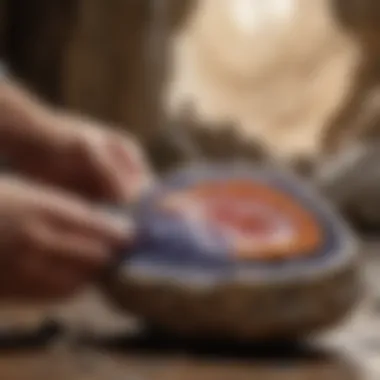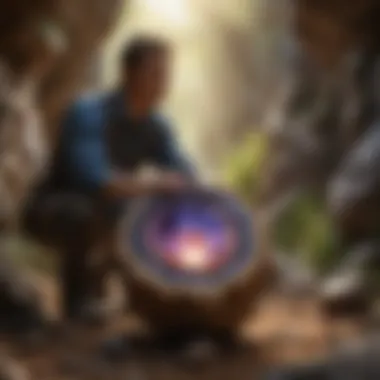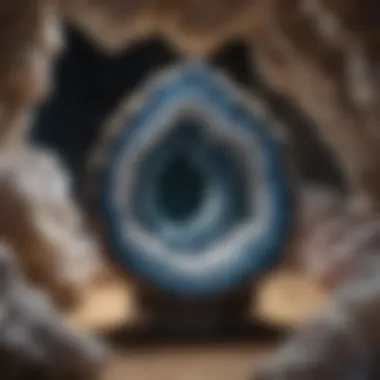Unlocking the Enigma: A Comprehensive Guide to Discovering Geodes


Rock and Fossil Identification
Geodes are fascinating geological formations that can contain beautiful crystals inside. When embarking on a geode-hunting adventure, it is crucial to be able to identify different types of rocks and fossils to increase the chances of finding these hidden treasures. A geode's outer layer may vary, but common rocks harboring geodes include igneous and sedimentary rocks. Fossils found near geodes can provide clues about the geological history of the area. Characteristics to look for in geodes include a round or oval shape, a rough exterior, and a hollow cavity inside. Tools such as rock hammers, chisels, and safety goggles are essential for extracting geodes safely and effectively.
Collecting Tips and Techniques
Exploring and collecting geodes can be a thrilling experience for rock and fossil enthusiasts. To maximize success in finding geodes, it is important to engage in best practices when collecting. Prime collecting sites often include areas with volcanic activity or sedimentary rock formations. Proper research and talking to local experts can help in locating these sites effectively. When extracting geodes, it is crucial to use caution and appropriate tools to avoid damaging the specimens. Techniques such as gentle tapping with a rock hammer and using a chisel can help in safely accessing the crystals inside geodes.
Preservation and Display
Once geodes are collected, it is essential to preserve them effectively to maintain their beauty and structural integrity. Techniques such as cleaning with mild soap and water, followed by air-drying, can help in preventing deterioration. Proper storage methods include placing geodes in padded boxes or drawers to protect them from impact and temperature fluctuations. To display geodes creatively, consider using glass cases with soft lighting to showcase their inner beauty while ensuring their long-term preservation.
Geological Insights
Geodes offer more than just aesthetic appeal; they also provide valuable insights into the geological history and processes of a region. Studying the geological formations where geodes are found can offer clues about past environmental conditions and the formation of crystals within the geodes. Additionally, the historical significance of rocks and fossils found near geodes can shed light on the earth's evolution over time. Notable discoveries in the field of geology have contributed to our understanding of Earth's natural history and the diverse range of minerals and crystals that exist.
Formation Process of Geodes
The formation of geodes is a fascinating geological process that unfolds over thousands to millions of years. Geodes originate when mineral-rich groundwater seeps into cavities or spaces within rocks such as limestone, dolomite, or volcanic formations. As the mineral-laden water slowly evaporates or cools, it deposits its contents layer by layer within the cavity. Over time, the minerals solidify and crystallize, creating the stunning formations we know as geodes. Factors such as pressure, temperature, mineral composition, and the surrounding rock matrix influence the color, size, and crystal structures found within geodes. Understanding the intricate formation process of geodes enhances appreciation for these natural wonders and provides insights into the earth's geological history.
Preparation for Geode Hunting
In the vast world of geode hunting, proper preparation is paramount for a successful and fulfilling experience. This section delves into the crucial aspects of preparing for a geode-hunting expedition, laying the foundation for an enriching adventure in search of these geological treasures. By understanding the significance of preparation, enthusiasts can maximize their chances of discovering stunning geodes and enjoying a seamless expedition.
Essential Gear and Tools
When embarking on a geode-hunting journey, having the right gear and tools is essential for success. From sturdy hiking boots to protective gear like gloves and safety goggles, each item plays a vital role in ensuring safety and enhancing the overall experience. Additionally, tools such as rock hammers, chisels, and magnifying lenses are indispensable for extracting and examining geodes effectively. Understanding the importance of each piece of equipment and selecting high-quality gear can make a significant difference in the success of a geode-hunting outing.
Researching Prime Geode Locations


Researching prime geode locations is a fundamental step in preparation for geode hunting. Knowledge of geological formations, soil composition, and historical data can help enthusiasts pinpoint areas with a higher likelihood of finding geodes. By exploring geological surveys, consulting local experts, and joining online forums dedicated to rock and fossil collecting, enthusiasts can gather valuable insights on promising geode hunting grounds. Understanding the characteristics of prime geode locations enhances the efficiency of the hunt and increases the chances of encountering remarkable specimens.
Understanding Geological Maps
Delving into the intricacies of geological maps is a valuable skill for geode hunters seeking to decipher the landscape and identify potential hiding spots for geodes. Geological maps provide crucial information on rock formations, mineral deposits, and topographical features that can guide enthusiasts to geologically rich areas. By interpreting geological maps with precision, individuals can locate areas of interest, plan their exploration routes strategically, and maximize their chances of unearthing geode treasures. Overall, a thorough understanding of geological maps empowers geode hunters to navigate terrain effectively and uncover hidden geological wonders.
Field Techniques for Geode Hunting
In the realm of geode hunting, mastering field techniques is paramount to unearth these mesmerizing geological formations effectively. This article delves into the significance of field techniques within the context of geode hunting, elucidating on various specific elements, benefits, and essential considerations associated with this crucial aspect.
Field techniques for geode hunting serve as the backbone of successful geode exploration. By employing systematic methods and strategies while in the field, enthusiasts dramatically enhance their prospects of discovering valuable geodes. These techniques encompass a wide array of practices, including proper geological surveying, meticulous observation of rock formations, and strategic excavation approaches.
The benefits of adeptly applying field techniques are manifold. Firstly, they substantially increase the likelihood of pinpointing prime geode locations. Secondly, these techniques assist in differentiating actual geodes from ordinary rocks, minimizing the chances of wasting time on insignificant findings. Moreover, honing field techniques refines one's geological skills, leading to a more enriching and rewarding geode-hunting experience overall.
When considering field techniques for geode hunting, several crucial considerations come into play. Enthusiasts must be well-versed in geological principles and rock formations to identify potential geode sites accurately. Additionally, prioritizing safety measures during field exploration is non-negotiable to ensure a secure and enjoyable hunting experience. Furthermore, being abreast of local regulations and environmental guidelines is essential to promote responsible geode collecting practices.
Visual Identification Tips
Visual identification tips play a pivotal role in the realm of geode hunting, aiding enthusiasts in discerning geodes from ordinary rocks based on visual cues alone. This section sheds light on the importance and nuances of visual identification tips, offering valuable insights into honing this essential skill.
One of the primary aspects of visual identification tips is the keen observation of external characteristics of rocks. Geodes often exhibit distinctive features such as spherical shape, lumpy texture, and unique color patterns, which can help differentiate them from surrounding rocks. By training the eyes to spot these defining attributes, enthusiasts can sharpen their ability to identify potential geodes in the field.
Furthermore, understanding the geological context in which geodes form is integral to effective visual identification. Different geological environments give rise to specific types of geodes, each with its unique visual signatures. By familiarizing themselves with these geological nuances, collectors can narrow down their search to locations more likely to yield geode treasures.
In essence, visual identification tips serve as a practical aid in the initial reconnaissance phase of geode hunting, guiding collectors towards promising sites and enriching their overall exploration experience.
Using Geophysical Tools
The utilization of geophysical tools marks a significant advancement in modern geode hunting practices, offering enthusiasts enhanced precision and efficiency in locating geode-rich areas. This section elucidates on the importance and utility of geophysical tools in the context of geode exploration, highlighting their indispensable role in augmenting traditional hunting methods.
Geophysical tools encompass a diverse range of instruments designed to detect subtle variations in the geological composition of terrains. By employing technologies such as ground-penetrating radar, electrical resistivity meters, and magnetometers, collectors can map underground structures and identify potential geode deposits with greater accuracy.


The primary benefit of using geophysical tools lies in their ability to unveil hidden geodes that may otherwise go unnoticed through conventional means. These tools penetrate beneath the surface layers, revealing geological anomalies that signify the presence of geode formations. Moreover, geophysical tools streamline the hunting process, reducing exploration time and allowing for more strategic deployment of resources.
However, it is imperative for enthusiasts to familiarize themselves with the operation and interpretation of geophysical tools to leverage their full potential effectively. Proper training and practice are essential to optimize the use of these sophisticated instruments and maximize geode-hunting success.
Exploring Caves and Rock Formations
Delving into caves and exploring intricate rock formations adds an exciting dimension to geode hunting, offering collectors the opportunity to discover geodes embedded within natural geological structures. This section delves into the merits and considerations of exploring caves and rock formations in the pursuit of geodes, emphasizing the unique insights and challenges posed by these environments.
Caves serve as natural repositories of geodes, harboring these hidden treasures within their cavernous depths. Venturing into caves requires meticulous planning and adherence to safety protocols, as navigating through tight passages and uneven terrains can present physical challenges. However, the rewards of uncovering pristine geodes nestled within cave walls make this exploration endeavor inherently captivating.
On the other hand, exploring rock formations in open-air landscapes opens up a plethora of possibilities for geode discovery. By closely inspecting the strata and geological layers of exposed rock formations, collectors can identify potential geode-rich zones and unearth these coveted specimens through careful excavation and observation.
Overall, the exploration of caves and rock formations provides a hands-on approach to geode hunting, inviting enthusiasts to immerse themselves in the geological wonders of the natural world and unravel the secrets hidden within these ancient formations.
Techniques for Opening Geodes
Techniques for opening geodes play a crucial role in the comprehensive guide on finding geodes. Delving into the methods of opening geodes provides enthusiasts with the means to uncover the hidden treasures within these geological marvels. By highlighting the various techniques available for opening geodes, this section equips rock and fossil collectors with the essential knowledge needed for a successful geode-hunting expedition.
Safely Cracking Geodes
Safely cracking geodes is a pivotal aspect when it comes to opening these geological wonders. Ensuring the safe cracking of geodes not only preserves the integrity of the geode itself but also safeguards the valuable crystals nestled inside. Rock and fossil collectors must understand the importance of using proper techniques to crack geodes to avoid damaging the exterior and losing the intricate contents within.
Tools for Opening Geodes
Choosing the right tools for opening geodes is instrumental in the geode-hunting process. From hammers to chisels, having the appropriate tools enhances the efficiency and safety of cracking open geodes. Each tool serves a specific purpose, whether it's breaking through the tough exterior or delicately extracting the crystals inside. Familiarizing oneself with the different tools available ensures that rock and fossil collectors can successfully unlock the hidden beauty of geodes in a precise and controlled manner.
Identifying Geode Contents
In this section of the comprehensive guide on finding geodes, the focus shifts to the crucial aspect of identifying geode contents, which plays a pivotal role in understanding the geological significance and beauty of these natural formations. By delving into the contents of geodes, rock and fossil collectors gain valuable insights into the unique treasures hidden within these seemingly ordinary rocks.
When it comes to identifying geode contents, enthusiasts can uncover a myriad of crystals, minerals, and other spectacular formations that have been forming within these geodes over centuries. By closely examining and categorizing these contents, collectors can enhance their knowledge of geology and appreciate the intricate beauty that each geode holds.


One of the key benefits of understanding and identifying geode contents is the opportunity to expand one's mineral collection with rare and visually stunning crystals. Discovering and identifying crystals within geodes can offer a sense of accomplishment and awe, showcasing the wonders of nature's geological processes. Additionally, recognizing different types of minerals and crystals allows collectors to create a more diverse and fascinating display of geological specimens.
Moreover, in the pursuit of identifying geode contents, collectors must consider the importance of proper identification techniques to differentiate between various minerals and crystals accurately. This attention to detail is essential for cataloging and preserving the integrity of a mineral collection, ensuring that each geode's contents are accurately represented.
Overall, the process of identifying geode contents contributes significantly to the overall experience of geode hunting, enriching collectors' understanding of geological formations and providing a deeper appreciation for the natural wonders found within these captivating rocks.
Preservation and Display of Geodes
In this informative guide on how to find geodes, the section on preservation and display plays a crucial role in enhancing the overall geode-hunting experience. Preserving geodes ensures their longevity and maintains their natural beauty, allowing collectors to enjoy them for years to come. Displaying geodes adds a touch of elegance and sophistication to any collection, showcasing these geological marvels in a way that is both visually appealing and educational.
Preservation of geodes involves careful handling and cleaning to prevent any damage to the delicate formations inside. By following proper preservation techniques, collectors can protect the outer surface of the geode as well as the crystals or minerals within. Keeping geodes in optimal condition is essential for preserving their intrinsic value and geological significance.
When it comes to displaying geodes, collectors have the opportunity to create stunning arrangements that highlight the unique features of each specimen. Whether arranging geodes by size, color, or mineral content, the display can serve as a conversation piece and a testament to the collector's passion for geology. Properly displayed geodes not only enhance the aesthetic appeal of a space but also provide a glimpse into the wonders of the natural world.
Taking the time to preserve and display geodes not only protects these geological treasures but also allows enthusiasts to share their fascination with others. By incorporating preservation and display techniques into their collecting routine, individuals can elevate their geode-hunting experience and cultivate a deeper appreciation for the beauty of the earth's hidden gems.
Ethical Considerations in Geode Collecting
Ethical considerations play a vital role in geode collecting, ensuring the sustainability and preservation of these geological treasures for future generations. In this article, we delve into the significance of maintaining ethical practices when engaging in geode hunting activities. By adhering to ethical guidelines, collectors contribute to the conservation of natural environments and promote responsible rock and fossil collection methods. Emphasizing the ethical dimension of geode hunting not only enhances the experience for enthusiasts but also promotes a harmonious relationship between humans and nature.
Respecting Natural Environments
Respecting natural environments is a fundamental ethical consideration when collecting geodes. It involves maintaining the integrity of ecosystems, habitats, and geological sites while pursuing the excitement of discovery. By treading lightly on the land, minimizing disturbances, and avoiding damage to flora and fauna, collectors demonstrate their commitment to environmental stewardship. Respecting natural environments goes beyond geode hunting; it reflects a profound appreciation for the interconnectedness of all living organisms and the need to protect biodiversity for future generations to marvel at.
Legal Regulations on Geode Collection
Understanding and adhering to legal regulations pertaining to geode collection is essential to avoid any legal infringements and protect geological sites. Laws and regulations vary from location to location, stipulating guidelines on where and how geodes can be collected. By familiarizing themselves with these regulations, collectors can ensure compliance and promote ethical conduct within the hobby. Legal requirements also serve to safeguard delicate ecosystems and geological formations, preserving the integrity of geode-rich areas for continued exploration and appreciation.
Conclusion
Geodes, with their hidden treasures within unassuming rocks, prove to be a fascinating subject for exploration. Throughout this comprehensive guide on unveiling the secrets of finding geodes, the importance of a well-rounded understanding of geode hunting techniques becomes apparent. By delving into the world of geodes, enthusiasts not only acquire valuable knowledge but also engage with nature on a deeper level.
In this article, the crucial elements of successful geode hunting have been highlighted, assisting rock and fossil collectors in their quest for these geological marvels. From the initial preparation phase to field techniques and preservation methods, every aspect has been meticulously discussed to equip readers with the necessary skills and insights.
One of the key benefits of this conclusive section is the emphasis on ethical considerations in geode collecting. Highlighting the importance of respecting natural environments and adhering to legal regulations ensures that geode enthusiasts engage in responsible collecting practices. These considerations not only protect the environment but also contribute to the sustainability of geode hunting for future generations to enjoy.
Moreover, the conclusion serves as a reminder of the excitement and fulfillment that comes with uncovering geodes. By following the guidelines outlined in this guide, rock and fossil collectors can enhance their geode-hunting experiences and develop a deeper appreciation for the geological wonders hidden beneath the surface. As enthusiasts apply the knowledge gained from this article, they embark on a journey filled with discovery, learning, and a profound connection to the natural world.







